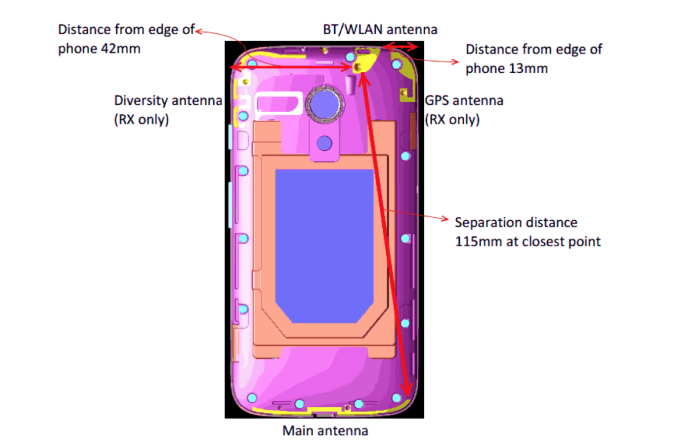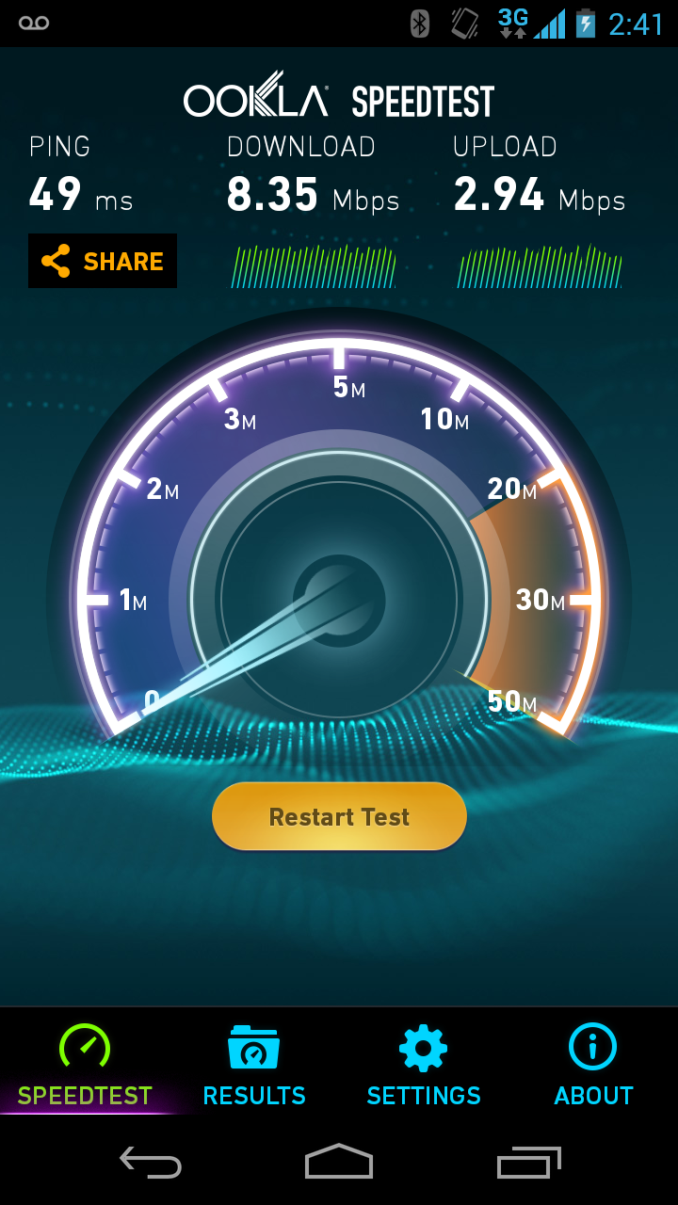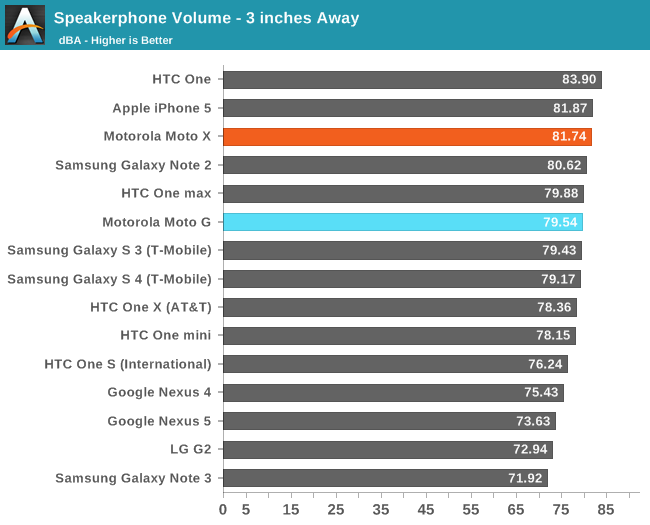Motorola Moto G Review
by Brian Klug on December 18, 2013 2:00 PM EST- Posted in
- Smartphones
- Motorola
- Mobile
- *VA
- Cortex A7
- snapdragon 400
- Moto G
Cellular
The cellular side of the Moto G is an interesting one, at least for those who have kept constantly abreast of wireless banding configurations and the state of mobile RF. At the high end, pentaband WCDMA is now essentially ubiquitous, with parity LTE banding (given the shared nature of ports on the transceiver) and at least a handful more bands for whatever’s appropriate to the region. There’s no global LTE band combination equivalent to quad band GSM or pentaband WCDMA that has emerged quite yet, but it’s getting there, and in the next generation or two we’ll undoubtedly finally see it come to fruition.
|
Moto G (US GSM) |
Moto G (Global GSM) |
Moto G (CDMA) |
|
| Baseband | MSM8x26 - (Up to HSDPA 21.1 Enabled, EVDO Rev.A for CDMA) | ||
| Transceiver | WTR2605/WFR2600 (?) | ||
| GSM | 850/900/1800/1900 MHz | - | |
| CDMA2000 | BC: 0/1/10 | - | 850, 1900 MHz |
| WCDMA |
850, 1700/2100 (AWS), 1900 MHz (Bands 2, 4, 5) |
850, 900, 1900, 2100 MHz (Bands 1,2,5,8) |
- |
| LTE | - | - | - |
The Moto G however comes in a number of different flavors with different band combinations – there’s US GSM, Global GSM, and CDMA. I also suspect there’s at least one more dual SIM variant that we haven’t seen crop up just yet (Update: Apparently this exists already, XT1033 is the dual SIM variant, thanks @evefavretto). On the back case of Moto G there’s a space whose shape matches the microSIM tray at top, and on the board there’s a shield covering pads that are undoubtedly for a microSIM. Interestingly enough Motorola sampled me the Global GSM variant of the Moto G which lacks Band 4. I’ve been using it on T-Mobile successfully however thanks to the relative ubiquity of the 1900 MHz WCDMA carrier in my market. The US GSM variant of the Moto G trades Band 4 for 1 and 8 (2100 and 900 MHz), two popular bands internationally. I’ve seen Moto G erroneously listed as being a pentaband WCDMA phone, which it unfortunately isn’t.

Primary Rx/Tx at bottom, Diversity Rx up top, WLAN/BT, GNSS Rx
Moto G does offer a leg up with receive diversity for CDMA1x/EVDO and HSPA+, something that some HSPA+ flagships from this generation amazingly enough still don’t include. The transceiver is WTR2605 for the primary Rx and Tx ports, and WFR2600 for the additional Rx diversity path. I have no idea what the port configurations look like for WTR2605, but I’d imagine it looks like a cut down WTR1605 of some kind. I have a suspicion that WTR2605 was designed for a quad band UMTS configuration with Bands 1,2,5, and 8, so it might indeed already be port limited in the Global GSM Moto G variant. I also wouldn’t be surprised if there’s some ready made front end module at the front of the whole thing.
Moto G arrives without LTE and instead offers up to single carrier HSPA+ with 64QAM, for up to 21 Mbps on the downlink. Although MSM8x26 itself has a modem block capable of up to dual carrier HSPA+ and category 4 LTE, it seems as though Motorola went for single carrier HSPA+ in the Moto G for time to market reasons, with the LTE and dual-carrier HSPA+ enabled software tree likely slotting in a quarter later than the initial code drop with single carrier HSPA+.


Not bad for single carrier HSPA+ on T-Mobile USA
I’ve been pretty pleased with the cellular performance of the Moto G, even using the variant that lacks Band 4 on T-Mobile USA. Not having LTE made me initially skeptical of it getting operator traction in the US, but it seems as though Motorola has actually had success at least on some prepaid tiers. I’ve been spoiled with LTE devices for a long time now, but single carrier HSPA+ is absolutely still survivable.
WLAN
WiFi connectivity on Moto G is single band 2.4 GHz 802.11n with BT 4.0 and FM receive. On the Moto G, that connectivity is courtesy the new WCN3620 BT/FM/WLAN RF combo chip in a wafer scale package. We’ve now seen WCN3660, the initial dual band combo, then WCN3680 which added 802.11ac, and now WCN3620, the cost reduced version which is single band 802.11n and no doubt offered at a competitive price point with the rest of the platform.
The WLAN/BT stack doesn’t do any antenna sharing and instead has its own transmit and receive path on the top of the Moto G. I don’t have any complaints about WLAN range on the Moto G.
To evaluate performance we turn to the same iPerf test same as always. I was able to attach the Moto G to my network at the 65 Mbps PHY rate that corresponds to long guard interval with a 20 MHz channel.

Performance is pretty decent at just over 50 Mbps. It’s a significant delta over the latest devices with dual band 80 MHz 802.11ac support, but again, totally solid relative to the tier it’s in.
Speakerphone and Noise Canceling
Speakerphone on the Moto G seems to be a big chamber if you take the back off, but there’s a relatively small seal against the whole affair, although the grille has larger holes than Moto X’s relatively tiny ones. Loudness is competitive, but unsurprisingly short of Moto X.

I’d describe Moto G’s speaker as decent, not overly loud or rich sounding.
Dual microphone noise suppression is still a somewhat notable feature at the midrange. In the case of Moto G, Qualcomm’s Fluence package is used in a configuration with the primary microphone at bottom and secondary at very top. I did some digging and also found that Moto G is using Qualcomm’s WCD9302 audio codec which we haven’t seen before, again a more midrange variant. I’ll leave the earphone/line out audio testing for Chris to evaluate.
Noise suppression on the Moto G is decent, but seems to have longer adaptation time than the Moto X. Using the exact same setup, I definitely noticed better rejection on Moto X as well, with less noise being passed through at the same volume level. I should also note that the Moto G does not appear to be AMR-WB enabled on T-Mobile.
GNSS
GNSS onboard the Moto G is the same Gen 8B as we’ve seen on 8974, which translates to support for GPS (USA “Navstar”), GLONASS (Russia), and Beidou (China), although the spec table for Moto G only lists GPS and GLONASS, leading me to believe Beidou might be reserved for devices destined for China. There’s a discrete antenna for GNSS on the Moto G, and I had no issues with getting fast, accurate 3D fixes. I remain impressed with Qualcomm’s GNSS which obviously benefits from integration right into the SoC.










120 Comments
View All Comments
ESC2000 - Monday, December 23, 2013 - link
I always appreciate the extensive numbers you guys collect to lend some objectivity to your conclusions rather than offering unsubstantiated impressions and opinions like all other reviews. That said it is interesting to me that people's responses to various displays are so individual-specific. Even though the Samsung phones don't seemto score well other than in black levels of course, I still prefer their displays over most of the other phones on which you gathered data. Overall it looks like the iPhone did the best (although it looks like in some categories - whiteness, grayscale - it regressed from the 5 to the 5s) but I've never liked the displays on iphones. It is hard to evaluate on the 5s because I dislike the color scheme of iOS 7, a strange mixture of pastels and bright red.a1exh - Saturday, December 28, 2013 - link
Nice review. But you missed that the Moto G doesn't have MHL (HDMI out over USB). This feature has been on all my phones for the last few years and is a must have when visiting relatives without a smart TV. I wonder why such an easy feature was omitted?BallGum - Saturday, December 28, 2013 - link
Does anyone expect an update to the Moto G sometime, with the new SnapDragon 410 SoC?Gothmoth - Sunday, December 29, 2013 - link
do you think writing "DELTA" all the time makes you look l33t3?you sound like a cheap wanaabe nerd repeating this "DELTA" over and over.
otherwise the article is nice....
Davidjan - Sunday, January 19, 2014 - link
Really cool! Nice gadget to add Moto G's storage- a tiny MicroSD reader: http://goo.gl/2iJ6gforenlevy - Thursday, January 23, 2014 - link
America ,iphone,nexus updates??? well i have xiaomi mi2s and every week there is ota update,hardware-beast, snapdragon 600 2G ram ,well updates with reach feature but android version change each year .but most kitkat updates already there for monthes, add cloud service includes apps & setting,gallery,logs,sms ect backup ,firewall ,antivirus, ftp server...2 paratiton each time the other update during system on! it is possible and it is hear for 300$ camera i have very nice shoot in darkness using night mode also video in club,i think the near feuture will be chinees company like that,service....updates....every week....
shmotog - Sunday, February 2, 2014 - link
I did my video review on the black flip shell for moto g here http://www.youtube.com/watch?v=ZsnWYpOjDzk&fea...Also here http://www.amazon.co.uk/review/RALAUPNHK9K8U/ref=c...
I also did a review on moto g itself here http://www.youtube.com/watch?v=AP9dGAzfEso
jfelano - Tuesday, February 4, 2014 - link
G stands for GOOGLE duh. Google just bought Motorola.sephirotic - Wednesday, February 5, 2014 - link
No micro SD? "This is a new tendency"? That's ridiculous. This phone is automatically excluded from my next smartphone possible-upgrade lists. No quad core, 720p or "ultra-cheap price"can compensate for that. There has been 50USD phones from 10 years ago that already had micro sd support. This is utterly unacceptable. If you don´t live in US or EU you can´t count on unreliable and limited internet to rely on cloud services. Even so, you can´t install all applications or produce most content relying on remote files. What's the point of a fast processor, good gpu and large screen if you can´t install anything in it or fill it with movies and music? Net surfing and google maps? You don´t need a quad core for that... Only casual users would not see all the drawbacks of being completely limited on local storage. Cloud storage is not "the future", maybe for the casual illiterate user, but for us, power-users and non-US/EU residents, is just a nightmare. I rather expend 30% more on a similar spec phone (even a dual core) with external storage than buying this. I don´t understand how this can appeal to the "masses". Maybe the US "masses", because the rest of the world doesn´t have decent unlimited internet to rely on clound services at all.wolfram74 - Tuesday, February 25, 2014 - link
The camera review does not speaks about speed, time to focus, lag etc. I didn't get the whole information needed about camera.